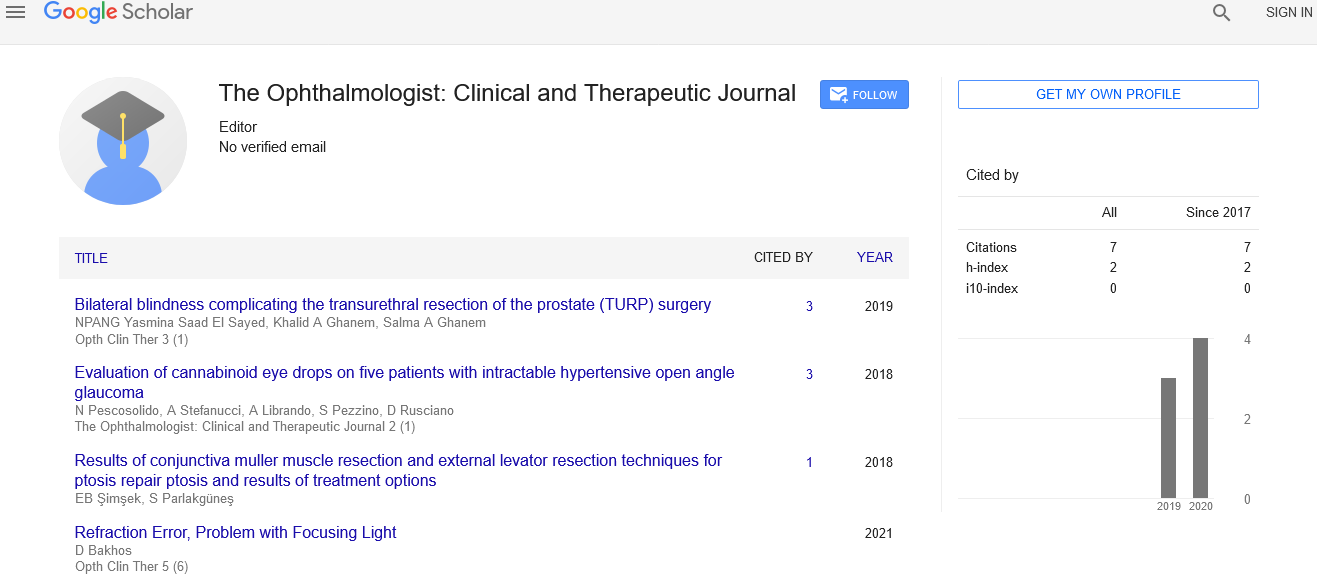Successful medical treatment on a case of extra-ocular myocysticercosis
Received: 23-Mar-2021 Accepted Date: Apr 07, 2021; Published: 14-Apr-2021
Citation: Mon AM. Successful medical treatment on a case of extra-ocular myocysticercosis. Opth Clin Ther. 2021;5(3):1-2.
This open-access article is distributed under the terms of the Creative Commons Attribution Non-Commercial License (CC BY-NC) (http://creativecommons.org/licenses/by-nc/4.0/), which permits reuse, distribution and reproduction of the article, provided that the original work is properly cited and the reuse is restricted to noncommercial purposes. For commercial reuse, contact reprints@pulsus.com
Introduction
Cysticercosis is caused by Cysticercus cellulosae, the larval form of pork tapeworm, Taenia solium. It is endemic in developing countries and the areas of poor sanitation. Ingestion of uncooked pork is one of the commonest etiologies. But sometimes it can happen in vegetarians also and it is due to the ingestion of contaminated water containing eggs. Human are the intermediate host. Inside the human body, the cysticerci transform into larvae and penetrate intestines to reach the blood stream. The most prevalent locations for cysticercosis are Central Nervous System (CNS), eyes, heart, and muscles subcutaneous tissues [1] and depending on the number of lesions, site of involvement and host immune response to the parasite, clinical features are different.
About the Study
I would like to mention two cases of extra ocular myocysticercosis which weresuccessfully treated with standard medical therapy alone. The first case is 19 years old male patient presented with ptosis of right eye associated with mild swelling of upper lid for two weeks (Figure 1). He had good levator function and normal ocular motility in all gazes. ELISA for cysticercosis was negative. The contrast enhanced Computed Tomography (CT) imaging of the head and orbit was done for the diagnosis. The CT showed bulky right superior rectus muscle with ring enhancing hypo dense lesion suggestive of right eye myocysticercosis involving superior rectus muscle (Figure 2). After the final diagnosis, he was treated with oral prednisolone 50 mg per day (1 mg/kg) with tapering 10 mg weekly for total 5 weeks and five days after starting prednisolone, oral albendazole 400 mg two times per day (15 mg/ kg) was given for total 4 weeks. The patient was significantly improved at 1 month follow-up (Figure 3) and vertical Inter Palpebral Height (IPH) were normal and equal in both eyes at 3 months follow-up [2]. The second similar case is the 15 years old girl presented with painful swelling and ptosis of right upper lid since 5 days (Figure 4). The CT scan findings showed ill-defined small size hypo dense lesion with central hyper dense in medial rectus muscle region of right eye (Figure 5). She was also treated with the same standard regime as above case and significant improvement after 3 weeks (Figure 6).
Discussion
Ocular cysticercosis can be extra ocular or intraocular and may show different clinical presentations which rises a clinical challenge to the ophthalmologists [1]. The common ocular manifestations are periocular swelling, proptosis, ptosis, pain and diplopia, restriction of eye movement, decreased vision, lid oedema and orbital cellulitis [3]. Few cases of ocular myocysticercosis presenting with ptosis were reported in some literature [4-6].
The diagnosis of ocular cysticercosis can be made clinically but need to confirm with the findings of ocular ultrasound (B-scan) and radiological imaging (CT scan). In B-scan, it shows a well-defined cystic lesion and a hyper echoic area suggestive of scolex. Initial ultrasonography is preferred to CT scan because it is easily available and cheaper. Some studies compared ocular ultrasound and CT scan and concluded that both are equally effective [7].
With this standard medical treatment regime of oral prednisolone (1 mg/kg) tapering weekly for one month followed by oral albendazole (5 mg/kg) for one month, clinical improvement was achieved in 92.8% of patients at one month and in 95.3% of patients at 3 months [8].
Conclusion
Therefore young patient presenting with recent unilateral ptosis could be a differential diagnosis of extra ocular muscle cysticercosis and a complete clinical improvement can be achieved with standard medical therapy alone.
Conflict of Interest
None
Patient Consent
The patients have no objection to participate in research work and case presentation and allow to use their photos for academic purposes.
REFERENCES
- Bouteille B. Epidemiology of cysticercosis and neurocysticercosis. Med Sante Trop. 2014;24(4):367-374.
- Mon AM, Rajbhandari Y, Limbu b, et al. Ocular myocysticercosis: A typical presentation with unilateral blepharoptosis. Indian J Clin Exp Ophthalmol 2020;6(3):463-466.
- Dhiman R, Devi S, Duraipandi K, et al. Cysticercosis of the eye. Int J Ophthalmol. 2017;10:1319-1324.
- Agrawal S, Ranjan S, Mishra A. Ocular myocysticercosis: an unusual case of ptosis. Nepal J Ophthalmol. 2013;5(2):279-281.
- Labh R, Sharma A. Ptosis: A Rare Presentation of Ocular Cysticercosis. Nepal J Ophthalmol. 2013;5(9):133-135.
- Kundra R, Kundra SN. Uniocular ptosis due to cysticercosis of extraocular muscle. Ind J Pediatrics. 2004;71(2):181-182.
- Sekhar GC, Honavar SG. Myocysticercosis: experience with imaging and therapy. Ophthalmology.1999;106:2336-2340
- Rath S, Honavar SG, Naik M, et al. Orbital cysticercosis: clinical manifestations, diagnosis, management, and outcome. Ophthalmology. 2010;117(3):600-605.











